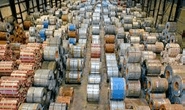Economy

Margins Tight in a “Sluggish” Secondary Steel Market
Written by Tim Triplett
June 4, 2019
With prime steel prices continuing to slide, market conditions for distributors of secondary steel are a bit discouraging. The cheaper the prime products, the less incentive for buyers to seek out deals on nonprime material.
Nonprime or secondary steel includes coils that are rejected because they failed to meet the specifications for their original use, but may be suitable for other customers with alternative applications. President Trump’s decision to rescind the Section 232 tariffs on steel from Canada and Mexico has had little effect on the secondary market, at least so far, report distributors.
Trump’s threat last week to place escalating tariffs on all Mexican exports to the U.S., including steel, if Mexico does not do more to stem the flow of immigrants to the north has only added to the uncertainty keeping steel buyers on the sidelines, say steel executives.
Secondary steel prices normally track up and down with prime steel prices. SMU’s average benchmark price for prime hot rolled has dipped by 30 percent in the past year to less than $600 per ton on sluggish demand and weak ferrous scrap prices. Secondary has largely followed suit, except for the plain vanilla, high-demand items, which have maintained an unusually high spot price, one not far enough below their prime counterparts to entice many buyers.
Mike Barnett, president of Grand Steel Products, Wixom, Mich., said the market has been eerily quiet. Removal of the tariffs has not yet had any noticeable impact in his area. People feared opening the borders would drive prices downward, but with steel already at such low levels, the effect is muted. “Demand is not that great for this time of year. Buyers are sitting on their hands, especially in the nonprime market, because they think the price still has room to move lower,” he said.
Competition is especially intense in the nonprime market today as service centers discount heavily to move high-priced inventory and generate cash so they can replace it with cheaper material. Thus, the downward pressure on prices is at least partly self-inflicted. “Our margins are skinny. The opportunities are still there, but the margins are not great in nonprime sales to end users,” Barnett said.
Greg Gross, director of purchasing and sales and COO at Blackhawk Steel Corp. in Chicago calls it a “hurry-up-and-wait kind of marketplace.” The spot market, where secondary steel is bought and sold, has been unusually sluggish for the last two months as buyers remain hesitant and indecisive. “People are afraid to make a move. Their greatest fear is buying inventory that will be devalued in 60 days,” he said, noting that secondary is at least $40 per ton cheaper than it was back in April. Orders are smaller and more frequent as buyers wait for signs the market is turning around. “There really is no speculation in the marketplace because everyone is waiting for the new starting line,” Gross said.
“People have anxiety fatigue,” said Lisa Goldenberg, president of Delaware Steel of Pennsylvania, Fort Washington, Pa., echoing Barnett and Gross. “Parts of the economy are doing very well, yet it seems like there’s a new crisis every day [such as the proposed tariffs on Mexico]. It just makes things very volatile.” Delaware Steel’s volume is down about 15 percent as customers remain hesitant to buy, though order activity has seen some improvement in the past two weeks, she said.
Secondary material is readily available, but the market is not oversupplied as one might expect from a domestic steel industry cranking out tonnage at more than 80 percent capacity. Secondary material typically represents just a small, single-digit percentage of mill output. So, an increase in capacity utilization from the high 70s to the low 80s does not generate that much more nonprime, explained Goldenberg. What does are big market events such as a crisis abroad, a major shift in auto production or some other unexpected change that prompts an inventory liquidation.
Asked when the market can expect a turnaround, Goldenberg said: “By July, if scrap settles higher, we could see a brief uptick that will catch some wind in our sales.” But she did not express a lot of confidence in her prediction.
Gross thinks the turnaround is more likely sometime this fall as pent-up demand finally pushes prices upward, at least temporarily.
Much depends on market sentiment, which shifts day to day from one presidential tweet to the next. Political decisions seem to be more influential and reactive and are having a measurable effect on steel pricing more than ever before, Gross observed. “I can’t recall any time when the politics of the world were so in the steel market’s face. Agree with it or not, never has it been such a part of the conversation.”

Tim Triplett
Read more from Tim TriplettLatest in Economy

New York state manufacturing index drops again in April
Firms were pessimistic, with the future general business conditions index falling to its second lowest reading in the more than 20-year history of the survey

Construction adds 13,000 jobs in March
The construction sector added 13,000 jobs, seasonally adjusted, in March, but tariffs could undermine the industry.

Supply chains, end-users brace for impact from tariffs
Supply chains are working through what the tariffs mean for them

ISM: Manufacturing expansion loses steam after two months of growth
US manufacturing activity slowed in March after two straight months of expansion, according to supply executives contributing to the Institute for Supply Management (ISM)’s latest report.

Chicago Business Barometer rose to 16-month high in March
The Chicago Business Barometer increased for the third-consecutive month in March. Despite this, it still reflects contracting business conditions, as it has since December 2023.
